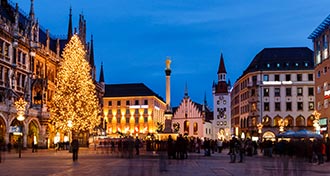
From Stuttgart, drive to Munich, the vibrant hub of southern Germany, full of world-class museums, historic churches and palaces, beautiful parks, opera, symphony, and, of course, famous beer halls. Oktoberfest, which starts in September and draws some five million revelers, is Europe’s biggest brew bash. (If you’re thinking of visiting Munich during Oktoberfest, it’s imperative that you book your hotel well in advance.)
Get your bearings in the area surrounding Marienplatz. From on top of the Neues Rathaus (New City Hall), famous for its Glockenspiel, you can get a good view of the city center, including the nearby 15th-century Frauenkirche. Get your historic fix at the Residenz, a palace that was the seat of the Wittelsbach family, the rulers of Bavaria, from 1385 to 1918. Art lovers should head to Munich’s Museum Quarter, home to the Alte and Neue Pinakothek, as well as the Pinakothek der Moderne. The collections here are world-class. For a change of pace, stroll in the Englischer Garten, the oldest public park in the world. A beer garden occupies the plaza near the Chinesischer Turm (Chinese Tower). From here, it’s a short stroll to the Schwabing district, home to Michelin-lauded Tantris restaurant.
For a change of pace, head to Olympiapark and pay a visit to BMW Welt (BMW World). Architecturally, the BMW showroom is a dramatic structure with a glass-enclosed spiral ramp that leads up to a sky bridge to the museum and factory buildings. Or, head out to Schloss Nymphenburg, five miles northwest of the city center. The Wittelsbachs’ summer residence, this is one of the most sophisticated palaces in Europe. The Porzellan-Manufaktur-Nymphenburg still produces the famous Nymphenburg porcelain here. Save time to explore the 500-acre park and the Amalienburg, a riot of Rococo excess. Back in town, dine on Bavarian specialties at Spatenhaus, a Munich beer restaurant with big windows overlooking the opera house. Munich has an international reputation when it comes to music, so you may want to attend a performance by the Munich Opera or Munich Philharmonic during your stay.
